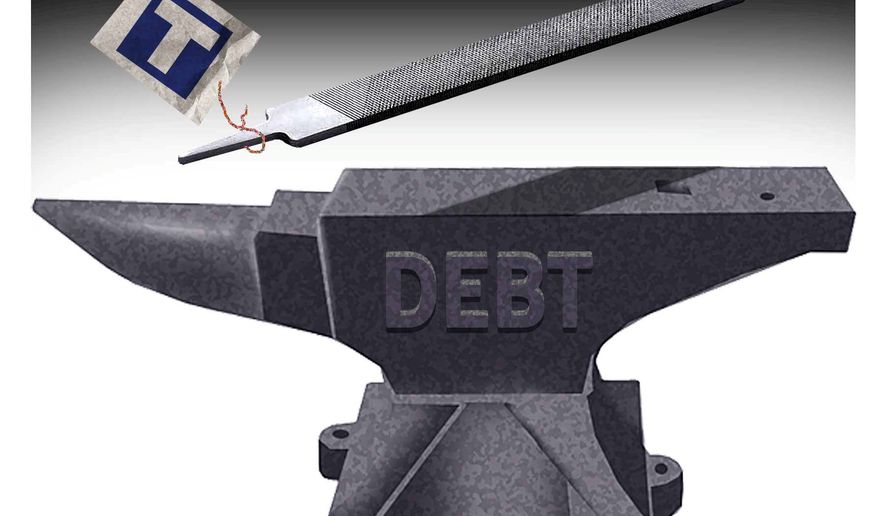OPINION:
Republican nominee Donald Trump’s recently unveiled economic plan was roundly praised for its aggressive pro-growth, job-creating proposals. He would cut income tax rates; increase exemptions for individuals; reduce the number of personal income tax brackets from seven to three; slash the corporate tax to 15 percent, taking it from the highest in the developed world to nearly the lowest; and eliminate the death tax and the destructive alternative minimum tax. Dramatic tax reform is a political winner given the oppressive burdens imposed by the current Byzantine tax code.
As strong as Mr. Trump’s plan is, however, it doesn’t adequately address something fundamental to truly bringing America back to full economic health: out-of-control government spending and the staggering national debt, currently racing toward $20 trillion and threatening to cripple the nation beyond recognition.
Mr. Trump believes — rightly — that the economic growth generated by his proposals will greatly reduce the debt burden. But given the magnitude of the debt, growth is necessary but not sufficient. Proposals to cut spending and reduce the debt may be unlikely to score Mr. Trump many votes, but they will demonstrate his seriousness about our long-term economic well-being, particularly when President Obama will add more than $8 trillion in debt, more than his 43 predecessors combined, and when Hillary Clinton is running on expanding the menu of taxpayer-subsidized freebies, from health care to college.
Out of the gate, Mr. Trump should demand a fundamental attitude adjustment on spending. By adding to the deficit, the feds are stopping businesses from borrowing to create jobs and blocking consumers from getting the capital they need. Treasury debt is up by about 40 percent over the past few years while commercial and consumer debt is down by roughly 20 percent. There’s very little movement in the broader economy largely because the government is monopolizing the loan window. The entire economy is tied into the spending levels of Washington.
We can no longer tolerate a federal government that refuses to restrain even the growth of government, never mind refusing to actually cut it. We need a fundamental change in the budget’s engineering, something current House Speaker Paul Ryan began to propose with the Republicans’ 2012 budget. His program may or may not be the endgame, but it — like Mr. Obama’s blown-off bipartisan deficit reduction commission — truthfully acknowledged the gravity of the economic battle, and the weapons and will we’re going to need to fight it.
To start, Mr. Trump should aim to shrink spending by trillions of dollars over the next 10 years. We’ve got to reduce the percentage of debt to gross domestic product (GDP) and adjust the spending trajectory to bring down the debt. Mr. Ryan’s plan would have brought spending below 20 percent of GDP. Other recommendations went even further, aiming to push federal spending down to 18 percent. In the context of a nearly $20 trillion-plus national debt, it’s not a cure-all, but it’s a beginning.
Several key reforms can effectively bring spending down. Spending on domestic government agencies should be brought to or below 2008 levels and frozen for five years, while unnecessary and redundant departments and bureaucracies should be eliminated entirely. If the government wants to study the mating habits of the North American egret, then it should get a private organization to fund it.
Also, permanently banning earmarks, getting rid of Fannie Mae, Freddie Mac and other tax dollar-sucking government-sponsored enterprises, eliminating “green” and other subsidies, and reducing the federal work force would cut federal outlays significantly. Democrats love to moan about wasteful spending at the Pentagon, but they should be targeted cuts rather than the buzz saw Obama cuts and the pell-mell reductions that occurred thanks to the Supercommittee mega-choke.
We’re in such a deep debt hole that if Mr. Ryan’s reform plans were put in place now and kept “as is” (which never happens in Washington over any duration), it would still take nearly 30 years to balance the budget.
Sen. Rob Portman, Ohio Republican, who served on the Supercommittee, has suggested a “dollar-for-dollar rule” as a permanent debt-limit policy. He argued that if we match debt increases with spending cuts, we could cut more than $5 trillion over the next decade and balance the budget without raising tax rates. Former Rep. Connie Mack advanced the “Mack-Penny” plan, which would have cut federal spending by 1 percent each year over the next six years, cap spending at 18 percent of GDP by 2018 and reduce overall spending by $7.5 trillion over 10 years.
We can debate these plans’ individual merits, but we can’t stall deep spending cuts for much longer.
Mr. Trump should argue that in order to restore the nation, we must remove the sources of economic destruction and uncertainty and replace them with approaches that will inspire confidence. This will require pro-growth, deregulatory and limited government, debt-slashing policies. In other words, doing the exact opposite of what Mr. Obama has done.
Getting the national debt under control is like turning around a battleship: laborious and largely thankless. But if Mr. Trump starts steering the ship in that direction now, he will prove himself a worthy captain.
Monica Crowley is editor of online opinion at The Washington Times.




Please read our comment policy before commenting.